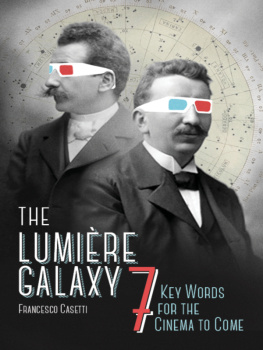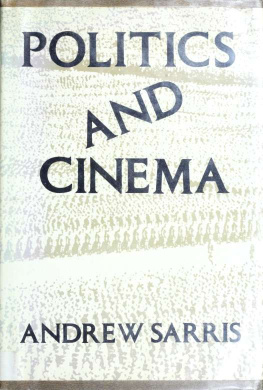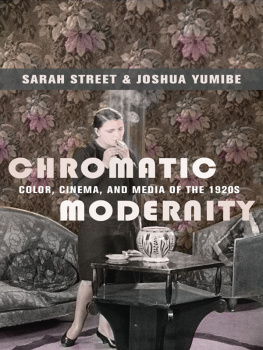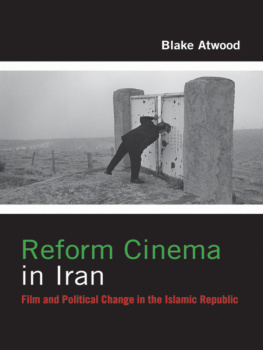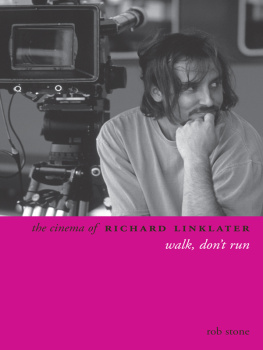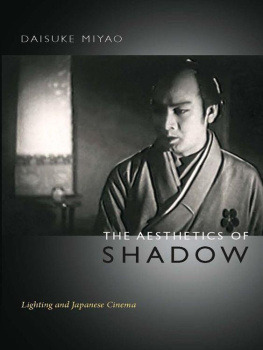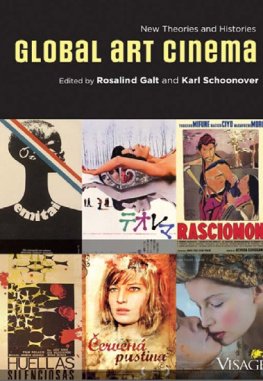The Lumire Galaxy
FILM AND CULTURE
John Belton, Editor
Film and Culture
A series of Columbia University Press
Edited by John Belton
For the list of titles in this series, see .
The Lumire Galaxy
SEVEN KEY WORDS FOR THE CINEMA TO COME
Francesco Casetti
Columbia University Press
New York
Columbia University Press
Publishers Since 1893
New York Chichester, West Sussex
cup.columbia.edu
Copyright 2015 Columbia University Press
All rights reserved
E-ISBN 978-0-231-53887-9
Library of Congress Cataloging-in-Publication Data
Casetti, Francesco.
The Lumire galaxy : seven key words for the cinema to come / Francesco Casetti.
pages cm. (Film and culture)
Includes bibliographical references and index.
ISBN 978-0-231-17242-4 (cloth : alk. paper) ISBN 978-0-231-17243-1 (pbk. : alk. paper) ISBN 978-0-231-53887-9 (ebook)
1. Motion pictures. 2. Digital mediaInfluence. I. Title.
PN1994.C34223 2015
384'.8dc23
2014030122
A Columbia University Press E-book.
CUP would be pleased to hear about your reading experience with this e-book at .
COVER DESIGN: Martin N. Hinze
COVER PHOTOS: (left) Portrait dAuguste Lumire, ca. 1890 (Collection Institut Lumire, Lyon); (right) portrait de Louis Lumire, ca. 1890 (Collection Institut Lumire, Lyon)
References to websites (URLs) were accurate at the time of writing. Neither the author nor Columbia University Press is responsible for URLs that may have expired or changed since the manuscript was prepared.
Contents
; to Laura Mulvey and Mark Lewis, who invited me to open the series The City and Its Moving Images, where I lectured on hypertopia. Thanks also to Phil Rosen, Michele Cometa, Pina De Luca, Ioanna Angelidou, Winfried Pauleit, Margrit Trhler, Laurent Creton, Roger Odin, Roberto De Gaetano, and Guglielmo Pescatore, who gave me the opportunity to speak in front of an audience about my work in progress.
Antonio Somaini and Peppino Ortoleva are accomplices, and their support and advice have been priceless. Sara Sampietro helped me between 2006 and 2009 to do some field work on the new forms of spectatorship that turned out to be very instructive. For years, I have always discussed my research with my colleague Maria Grazia Fanchi; many pages of this book resonate our conversations. As usual, my thanks to Silvio Alovisio and Luca Mazzei for helping me in my archival research on Italian early film theory. My gratitude also to Raymond Bellour and Pietro Montani for useful conversations at different stages of the work. The manuscript or parts of it have been read by Malte Hagener, Paul North, Giacomo Manzoli, Franco Marineo, Ruggero Eugeni, Federica Villa, Francesco Pitassio, Mauro Carbone, Ji-hoo Kim, and Andrea Pinottimy gratitude for their generosity and insight. Special thanks to Jimena Canales: The book found its final structure after a long discussion with her.
My colleagues at Yale deserve special thanks: I have learned a lot from passionate discussions with Carol Jacobs, Charles Musser, Brigitte Peucker, Katie Trumpener, Katie Clark, J. D. Connor, Aaron Gerow, Ron Gregg, Laura Wexler, and John Mackay. Part of the book was discussed at the Humanities Intramural Seminar, organized by Martin Hgglund: my thanks go to him and to Howard Bloch, Gary Tomlinson, Rudiger Campe, Ruth Yeazael, Tony Kronman, Bryan Garsten, Steven Smith, Tina Liu, and Josh Billing. David Joselit, with whom I have co-taught two courses, gave me the precious opportunity to share many ideas. Thanks to Emily Greenwood and Tamar Gendler for a fruitful intellectual engagement in the Mellon Initiative. Many of the ideas developed in this book have been debated in my seminars: a special recognition to my graduate studentsparticularly to Mal Ahern, Luca Peretti, and Andrej Tolstoy, who asked me to address the closing remarks at the Graduate Conference Expanding Cinema. Dudley Andrew is my American brother more than my American friend: all my gratitude for his closeness, his generosity, and the extraordinary gift of dedicating to me his What Cinema Is! His suspicious attitude toward so-called post-cinema has been a constant caveat in the face of my excess of enthusiasm; I have been impelled to dive deeper into my topic. This book is in dialogue with his.
has been published with another title and in a different form as the opening text in Public Spaces, Media Screens, edited by Chris Berry, Janet Harbord, and Rachel Moore. I want to thank the editors and publishers for letting me use this previously published material. Daniel Leisawitz has provided the translation of the pages previously written in Italian, and he also helped me to improve the parts directly written in English. I am greatly indebted to his efforts and his patience: The book owes much to him. For the final revision of the manuscript, I worked side by side with Michael Cramer: He helped me to find the best way of expressing my ideas, displaying extraordinary competence, great insight into my work, and a marvellous sense of elegancesomething needed for a book that is not written in my mother tongue.
Special thanks to Jennifer Crewe, director at Columbia: this is the second book that I have had the pleasure to publish with her. I would also like to acknowledge the hard work put in by the production team: Roy Thomas, production editor, Chris Curioli, copyeditor, and Ben Kolstad, who coordinated the production of this book.
The impulse to write this book arose from different episodes. When my previous book, Eye of the Century, was published, many friends and some of my reviewers asked me to write something on what at the time I called cinema 2.0. The Lumire Galaxy is an answer to their request. During my first steps in this project, another suggestion came from an anonymous bus driver: I was refusing to get out from the shuttle to Newark Airport, claiming that the film that was screened onboard had not yet run to its endand the driver answered that, being complimentary, due to a traffic jam, the movie was not properly a movie. I found it an interesting riddle. But what really moved me onward was a discussion with my wife, Ornella, with whom I watch movies in film theaters and on the large television screen in our living room. During screenings at home, she wants me to stay silent; once I reacted claiming that we were at home, where conversations are usual, and she replied that as a matter of fact we were watching a movie. This book is an attempt to understand why we were watching a movie and why we had to behave consequently, even if at home. The book, of course, is dedicated to Ornella.

